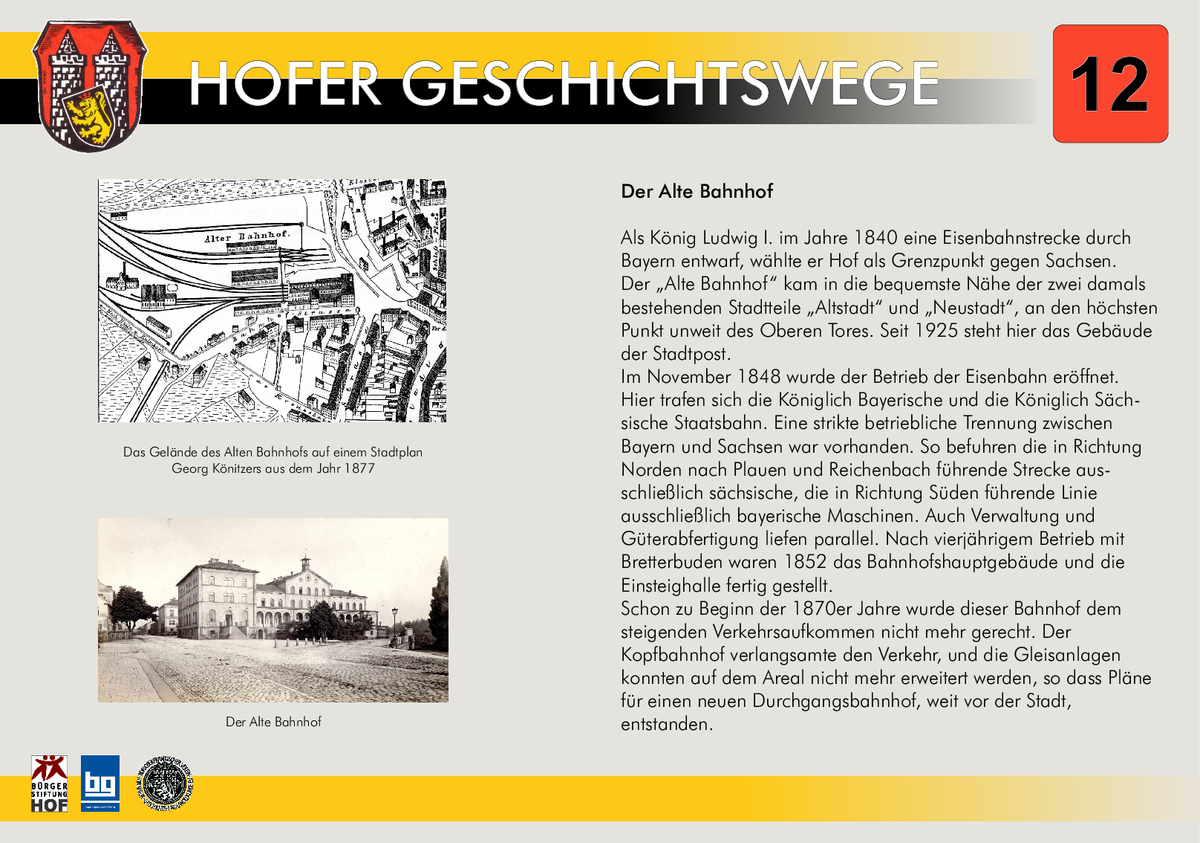Der alte Bahnhof
Hof als Grenzpunkt gegen Sachsen
Als König Ludwig I. im Jahre 1840 eine Eisenbahnstrecke durch Bayern entwarf, wählte er Hof als Grenzpunkt gegen Sachsen. Der „Alte Bahnhof“ kam in die bequemste Nähe der zwei damals bestehenden Stadtteile „Altstadt“ und „Neustadt“, an den höchsten Punkt unweit des Oberen Tores. Seit 1925 steht hier das Gebäude der Stadtpost.
Im November 1848 wurde der Betrieb der Eisenbahn eröffnet. Hier trafen sich die Königlich Bayerische und die Königlich Sächsische Staatsbahn. Eine strikte betriebliche Trennung zwischen Bayern und Sachsen war vorhanden. So befuhren die in Richtung Norden nach Plauen und Reichenbach führende Strecke ausschließlich sächsische, die in Richtung Süden führende Linie ausschließlich bayerische Maschinen. Auch Verwaltung und Güterabfertigung liefen parallel. Nach vierjährigem Betrieb mit Bretterbuden waren 1852 das Bahnhofshauptgebäude und die Einsteighalle fertig gestellt.
Schon zu Beginn der 1870er Jahre wurde dieser Bahnhof dem steigenden Verkehrsaufkommen nicht mehr gerecht. Der Kopfbahnhof verlangsamte den Verkehr, und die Gleisanlagen konnten auf dem Areal nicht mehr erweitert werden, so dass Pläne für einen neuen Durchgangsbahnhof, weit vor der Stadt, entstanden.
Das Gelände des Alten Bahnhofs auf einem Stadtplan Georg Könitzers aus dem Jahr 1877
When King Ludwig I designed a railway line through Bavaria in 1840, he chose Hof as the border point against Saxony. The "Old Station" came into the most convenient proximity of the two then existing districts "Old Town" and "New Town", at the highest point not far from the Upper Gate. Since 1925, the building of the city post office has stood here.
In November 1848, the railway opened for business. The Royal Bavarian and Royal Saxon State Railways met here. There was a strict operational separation between Bavaria and Saxony. Thus, the line leading north to Plauen and Reichenbach was operated exclusively by Saxon machines, the line leading south exclusively by Bavarian machines. Administration and goods handling also ran in parallel. After four years of operation with wooden huts, the main station building and the boarding hall were completed in 1852.
By the early 1870s, this station could no longer cope with the increasing volume of traffic. The terminus slowed down traffic and the tracks could no longer be extended on the site, so plans were made for a new through station, well ahead of the city.
The site of the old railway station on a map by Georg Könitzer from the year 1877
Když král Ludvík I. v roce 1840 navrhoval železniční trať přes Bavorsko, vybral si Hof jako hraniční bod se Saskem. "Staré nádraží" se ocitlo v nejvhodnější blízkosti dvou tehdy existujících čtvrtí "Staré město" a "Nové město", na nejvyšším místě nedaleko Horní brány. Od roku 1925 zde stojí budova městské pošty. V listopadu 1848 zde byla otevřena železnice.
Setkávaly se zde Královské bavorské a Královské saské státní dráhy. Mezi Bavorskem a Saskem existovalo přísné provozní oddělení. Trať vedoucí na sever do Plauen a Reichenbachu tak byla provozována výhradně saskými stroji, trať vedoucí na jih výhradně stroji bavorskými. Souběžně probíhala také administrativa a manipulace se zbožím. Po čtyřech letech provozu s dřevěnými chatkami byla v roce 1852 dokončena hlavní nádražní budova a nástupní hala.
Počátkem 70. let 19. století již tato stanice nezvládala narůstající objem dopravy. Koncová stanice zpomalovala dopravu a koleje již nebylo možné na místě prodloužit, proto byly vypracovány plány na výstavbu nové průjezdné stanice, daleko před městem.
Místo starého nádraží na mapě od Georga Könitzera z roku 1877
